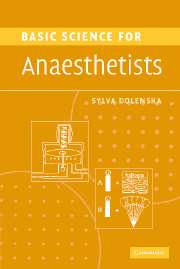Book contents
- Frontmatter
- Contents
- List of abbreviations and symbols
- List of figure captions
- Forewords
- Preface
- Preface to the second edition
- Part 1 Physics, mathematics, statistics, anaesthetic apparatus
- Part 2 Clinical measurement
- Part 3a Physiology: the cardiovascular system
- 1 The cardiac cycle and the intravascular pressure waveforms
- 2 Cardiovascular effects of intermittent positive pressure ventilation
- 3 Control of cardiac output, regulation of cardiac function
- 4 Cardiac cycle: pressure-volume relationships
- 5 Blood pressure and blood volume relationship
- 6 Cerebral blood flow
- 7 Coronary circulation
- Part 3b Physiology: the respiratory system
- Part 4 Pharmacology
- Further Reading
- Index
5 - Blood pressure and blood volume relationship
from Part 3a - Physiology: the cardiovascular system
Published online by Cambridge University Press: 13 August 2009
- Frontmatter
- Contents
- List of abbreviations and symbols
- List of figure captions
- Forewords
- Preface
- Preface to the second edition
- Part 1 Physics, mathematics, statistics, anaesthetic apparatus
- Part 2 Clinical measurement
- Part 3a Physiology: the cardiovascular system
- 1 The cardiac cycle and the intravascular pressure waveforms
- 2 Cardiovascular effects of intermittent positive pressure ventilation
- 3 Control of cardiac output, regulation of cardiac function
- 4 Cardiac cycle: pressure-volume relationships
- 5 Blood pressure and blood volume relationship
- 6 Cerebral blood flow
- 7 Coronary circulation
- Part 3b Physiology: the respiratory system
- Part 4 Pharmacology
- Further Reading
- Index
Summary
Following blood loss, the body draws on its reserves to maintain blood flow and oxygen delivery to the tissues. Initially, water is retained by the kidney and extracellular fluid is drawn into the intravascular compartment. If blood loss continues, physiological compensatory mechanisms bring about changes in other physiological parameters to maintain blood flow to the tissues, and in a more severe haemorrhage to the vital organs only. Haemorrhage is classified into four degrees of severity:
Class I: ≤ 15% or ≤ 750 ml blood loss. Stroke volume may fall minimally at lower levels of loss, resulting in a minimal tachycardia to maintain cardiac output. This is the situation induced by venesection in a blood donor.
Class II: 15–30% or 750–1500 ml blood loss. Tachycardia is noticeable while systolic blood pressure is still maintained; diastolic pressure, however, rises due to the higher level of circulating catecholamines. Mean blood pressure is maintained but flow to the organs without autoregulation of blood flow is reduced (e.g. muscle, skin). Because of the reduced skin blood flow, core-to-skin temperature difference starts to rise. Renal blood flow is minimally affected and urine output is maintained at a physiological minimum. Cerebral blood flow is maintained due to autoregulation but anxiety due to the circulating catecholamines is evident.
Class III: 30–40% or 1500–2000 ml blood loss. The compensatory mechanisms are being exhausted and circulatory failure starts to develop. Tachycardia is marked and there is a measurable fall in systolic blood pressure. Tachypnoea is present due to reduced O2 delivery to the tissues. Urine output decreases significantly, core-to-skin temperature difference increases further and mental changes are pronounced.
[…]
- Type
- Chapter
- Information
- Basic Science for Anaesthetists , pp. 122 - 123Publisher: Cambridge University PressPrint publication year: 2006



